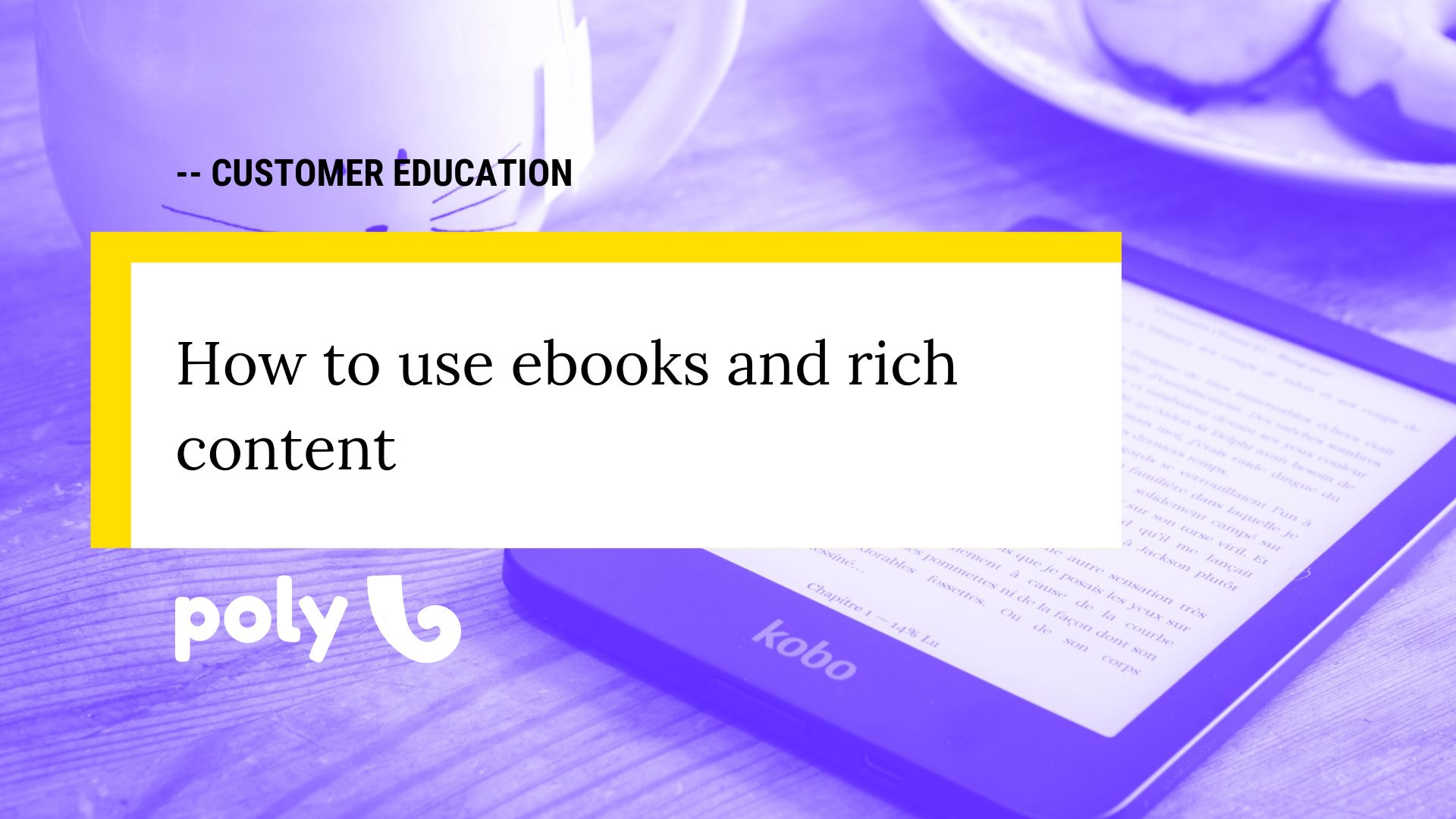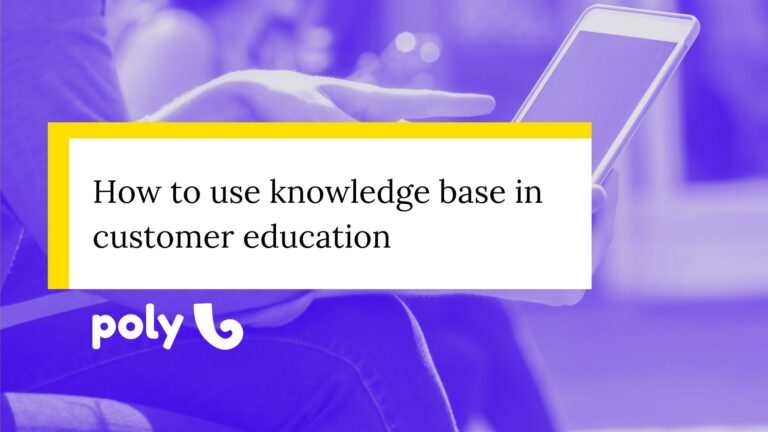How to use ebooks and rich content in Customer Education
You may have already noticed that ebooks are widely used in marketing strategies. On various websites, you’ll come across messages prompting you to download ebooks for more in-depth content. This is because ebooks are a great way to condense all the information about a specific topic into a more visually appealing and organized format, whether it’s about using software or dealing with your boss.
Consumers are increasingly seeking original and relevant information and content. This is why ebooks and rich content play a prominent online role. So today, we will talk more about rich content, its different types, how it relates to marketing and customer education. Ultimately, we’ll teach you the process of creating an ebook so that your company can stay caught up in this aspect.
What is rich content, and how do they fit into a marketing strategy?
Simply put, rich content refers to more in-depth content that utilizes various resources, regardless of the topic. It goes beyond the shorter content found on social media, which only provides a basic overview. Even blogs, despite their infinite programming possibilities, often only fully leverage some available options for the sake of practicality.
Rich content aims to educate readers about all aspects of a subject so that they are well-informed and able to discuss the topic confidently after reading it.
There are different types of rich content, but we’ll delve into that in the next section. What matters is the positive impact they have on your business. By positioning your brand as an authority on the subject, people who have read your content will remember your brand when they think about the topic. This happens because rich content is more immersive, interactive, and visually appealing, making the message clearer. Moreover, people who have learned from your rich content will share and recommend it to others, increasing its relevance.
Rich content is an essential part of a marketing strategy.
Furthermore, rich content is excellent for lead generation. You may have noticed that to download ebooks, you need to provide some information to gain access, right? This is where lead capture begins, as the data collected includes not only the name and email but also crucial information: interest in that particular topic. With the basic data, your team can use marketing strategies to qualify these leads and potentially convert them into customers.
Visitors can provide data to contribute to your marketing strategy without providing data. When they visit your page, you can teach the Facebook and Instagram algorithms who your ideal visitors are and train them accordingly. There’s also the possibility of working with remarketing and retargeting, two almost basic concepts in digital marketing nowadays.
The possibilities are enormous, far beyond what has been mentioned earlier. While the main objective is usually lead generation, creating rich content ensures that there is always content to be posted online, engaging more people and creating different opportunities for interaction with your audience.
Different types of rich content.
Rich content can be delivered through various platforms. Here, we’ll discuss four types to help you consider which one is best for your company.
The first type is ebooks, which we have already discussed in this article. Ebooks are a great way to provide rich content at a low cost. They are a simple way to share valuable information with your followers while generating leads with conversion potential.
Another method is webinars, live video sessions conducted over the internet. These events can delve deep into the content. Like ebooks, people need to provide data to access the webinar link, thus generating leads.
Webinars have considerably increased during the pandemic, as in-person courses were no longer possible. Companies began to value this format more for training and marketing their products.
The third way to provide rich content is through blogs with more comprehensive posts. It is important to note that these contents are usually associated with other graphical features, such as infographics. Both are great for delving deeper into content that would be less successful on Instagram and Facebook posts. This is because they would need to be shorter and lighter for a media that values quick content.
Finally, another form of rich content is online courses. Regardless of the platform, these courses present a logical order in which a complete and in-depth understanding of a particular subject is emphasized. The video format is interesting because it is slightly more relaxed than other modalities, and brands already use YouTube channels for this purpose.
Courses can be free or paid, short or long. You don’t have to stick to completing technical in-person courses that last 20 hours. A 30-minute course can fulfill the role of engaging your audience very well.
How to use rich content in Customer Education.
Customer Education and rich content are closely related; it is probably only possible to talk about one with touching on the other. The production of rich content should preferably be about topics that make sense for your brand.
A very interesting way to use rich content in customer education is to delve into issues that you have already noticed your customers have questions about. This solves two issues simultaneously since you will be producing content that interests your customers and helps them understand how certain features work.
Rich content can take different forms. Therefore, to implement your customer education strategy, focus on one of these platforms first and make it great before venturing into others.
Teaching and empowering your customers with rich content gives them much more authority on the subject. It’s a way to enhance your customer education strategy!
The process of creating an ebook.
Now that you understand what rich content is and the importance of having ebooks in your marketing strategy, we will provide you with the basic tools to start creating your own ebook.
This process is straightforward, but it may be challenging. Creating an ebook takes time and dedication, especially if you want to deliver something of quality. Therefore, plan well before starting to stay on course halfway through and save time redoing things that could have been invested in other activities.
The first step is to think about what the ebook will be about and what content you intend to write. If it’s your first ebook, try to focus on a subject you are familiar with, as the writing will flow much easier. If you’re a company, think of something related to what you sell or related to your brand.
This first ebook might be challenging initially because you still have no idea about the structure and the best way to express yourself. But don’t worry! These skills come with practice; the more you do, the better you will become.
Starting to write your first ebook.
With the chosen content, think about the structure of your text. What are the key points that should be addressed in this ebook? Are you writing a text to encourage readers to buy your product or demonstrate its importance? Think about the structure in a way that, in the end, you see coherence in the text with your objective.
For example, if your ebook is about how your brand benefits from internet consumption patterns, you won’t explain these patterns at the end of the text, right? It is an introductory subject so that you can delve deeper into it as a foundation. And this applies to any subject.
The basic structure is the introduction, development, and conclusion. Within this structure, you can include different topics and other relevant structures. At this point in the structure, it is also interesting to think about visual identity if you don’t have one. You are probably thinking of creating a series of ebooks and not just one, so think about a basic visual identity that all ebooks can follow a similar pattern.
If you want to learn how to write content, we at Poly offer a short course on Educational Content Production. Click here to check it out.
Improving content quality.
With the content and structure defined, it’s time actually to write this ebook. Look for different sources on the subject and delve into them so that your text is not a copy of other websites. Write in an original way and always keep your target audience in mind. Only try to use academic language or a few jargon terms if your ebook is intended for people who are just starting out in the subject.
After writing all the content, revise. This is one of the most important steps. Always have the material undergo a thorough review. You don’t want to provide material with incorrect data or concepts. This review can be done by yourself or by others.
Often, having someone else review the material is the best option because it will be their first time encountering it, and they will read it more carefully, actively looking for possible errors. If you have to take on this role yourself, give yourself a few days of rest so you can “forget” the material and review it as if it were the first time.
Learning to use rich materials in Customer Education.
With it all ready, it’s time to promote it. Here you can think in different ways. Just like any other internet content, you can use social media, blogs, and search engines. Think of keywords associated with your ebook. It’s no use having done impeccable work if your target audience won’t see it.
It is worth emphasizing that launching an ebook, a video, or a course does not mean you can wash your hands and consider the strategy a success. In fact, it’s always good to have a combination of tactics and give it time. There is always the possibility that one of your attempts will fail, and to overcome that, good metric management will be essential.
The important thing is to start somehow and improve over time.



